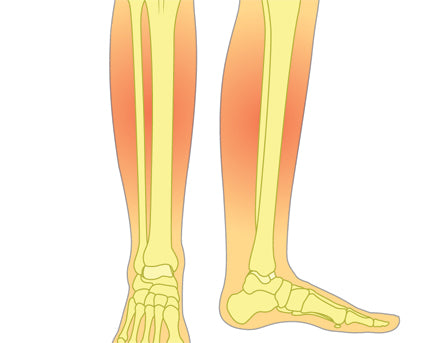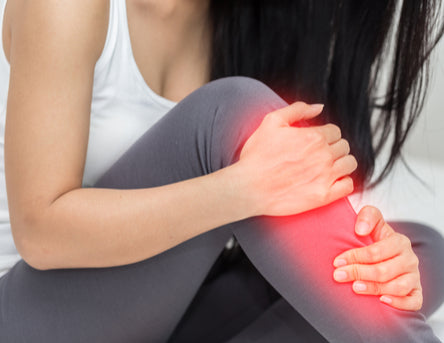Shin Splints
Recommended for Shin Splints
View allShin Splints Make Activity Difficult
Do you have throbbing or aching in your shins after running, or even after just a short sprint? You may be experiencing shin splints. Shin splints are a common development for those who frequently participate in strenuous physical activity, especially stop and start sports.

The pain is generally located on the front and medial side of the lower leg.
Browse our full collection of insoles for shin splints.
What Are Shin Splints?
Shins splints develop as the result of excessive force being placed on the shin bone and surrounding tissue. The force causes swelling in the muscles and increased pressure on the shin bone, which can cause pain and inflammation in the lower leg. Usually the pain, which is often a burning, throbbing, or aching, is experienced on the inside of your shin – the medial aspect of your lower leg. Less commonly, you may experience pain on the outside of your shin. Shin splints are the most painful when you try to lift your foot up at the ankle and flex your foot. This makes daily activities and especially athletic exercise difficult.

The pain can become so intense that activity must be stopped until the condition improves.
What Causes Shin Splints?
Most often shin splints are caused by strenuous athletic activity and irritated and swollen muscles. Running, jumping and kicking puts extra stress and force on the leg. Stop-and-start sports, such as basketball and tennis, put excessive stress on the lower leg making it more likely to develop shin splints if you are participating in these sports. At times when you are working out aggressively and frequently with a lot of pounding on your legs, bone fractures can occur. These are minute breaks in the lower leg bones. These small breaks will heal if you give them time to rest but can progress into a complete fracture if excessive force on the bone continues. Pain from shin splints is a strong indication that you need to change your routine and allow your body to heal and repair itself.
If you are experiencing shin splints it may be due to several factors. You may have increased your workout intensity suddenly or performed athletic exercise without stretching adequately. Even a change such as running on a different surface than normal could be contributing to your shin splints.
Body structure is another factor that should be considered in the cause of this condition. Pore lumbar spine function can contribute, as well as can arch structure and gait. Those with extremely flat feet or rigid, high arched feet tend to be more prone to developing shin splints than those with other foot types.

Most often shin splints are caused by strenuous athletic activity and irritated and swollen muscles.
What Can I Do?
Rest And Ice
Often shin splints will heal on their own with adequate rest and caution. Icing your shin for 20-30 a few times a day can help relieve the pain and minimize the swelling. Anti-inflammatory medication such as ibuprofen can also help to reduce the swelling. If the pain is severe make sure to see a doctor. It is not unusual for it to take 3 to 6 months for this condition to heal and it may be helpful to see a physical therapist to receive guidance in returning to your activity more quickly. You will want to refrain from exercising again until the shin splints have completely healed. Upon resuming athletic activity, it is very important to warm adequately before your work out and follow the activity by stretching the muscles in your leg.
Wear Proper Footwear
Good shoes with proper support are imperative when activity is resumed. Insoles and can also help increase shock absorption. If you have arches that collapse and flatten when you put weight on them, arch supports will help your foot to remain in an anatomically correct position during activity, therefore putting less stress and strain on your leg bones.








